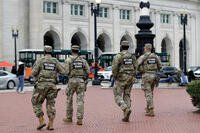If you're a National Guard or Reserve member moving into an activated status for more than 30 days, you qualify for Tricare under the same programs as all active-duty troops. That coverage lasts the length of your activated service.
How do activated Guard and Reserve members enroll in Tricare or shift their Tricare coverage from the Tricare Reserve Select plan to the active-duty plans? Here are the details.
How Activated Guard and Reserve Members Enroll in Tricare
When your Active Guard Reserve (AGR) Title 32 or Title 10 orders of 30 or more days are updated in the Pentagon's personnel system, known as the Defense Enrollment Eligibility Reporting System (DEERS), you are automatically enrolled in the Tricare Prime plan.
That plan allows you to receive primary and specialty care with no out-of-pocket costs, but does require referrals if you need to see anyone other than your primary care provider. If you live within about 45 minutes of a military treatment facility, it could also mean that you're required to be treated on base. That could be a big change if you already have medical care in your community that you know and like.
A second plan option, known as Tricare Select, allows you to be seen off base at a civilian doctor of your choice, and does not require referrals for specialty care. However, you will be required to pay cost shares, with a $1,000 cap each year. How much you pay for visits depends on when your service member first joined the military and whether your doctor is in-network.
Since your enrollment defaults to Tricare Prime, if you want to instead use the Tricare Select plan, you'll need to call your regional contractor. You can locate your regional contractor here.
How Activated Guard and Reserve Members Move from Tricare Reserve Select
When your orders of 30 or more days are updated in DEERS, your Tricare enrollment will automatically switch from Tricare Reserve Select, a plan for which you pay a monthly premium, to Tricare Prime, which carries no out-of-pocket costs for those who get referrals and see in-network doctors. Like those using Tricare for the first time, if you want to switch to Tricare Select, you'll need to contact your regional contractor.
How Tricare Costs Differ Between Tricare Reserve Select and Active-Duty Tricare
Tricare Reserve Select is a premium-based plan, and costs about $230 a month for a family. Once activated, the service member's care is provided on base at no cost, while the family is instead covered by one of the active-duty family Tricare plans. Unlike Tricare Reserve Select, those plans do not have a monthly premium fee.
Tricare Reserve Select carries deductibles and cost shares set by federal law, tied to a schedule known as "Group B," regardless of when the service member joined.
Activated families can choose to use Tricare Prime, which carries no fees so long as users follow referral rules, or Tricare Select, which comes with out-of-pocket fees at many visits, just like Tricare Reserve Select.
Related: Tricare Cost Co-Pay Schedule
How much activated families on Tricare Select pay, however, depends on when the service member originally joined. If that date was before Jan. 1, 2018, the fees are tied to a schedule known as "Group A." If they joined after that date, the fees are tied to the same schedule as Tricare Reserve Select, "Group B." That means that, depending on original join-up date, your out-of-pocket fees on Tricare Select may be the same as they were on Tricare Reserve Select.
Out-of-Pocket Costs Don't Reset When You Switch
When you switch plans due to activation or any change in status, such as retirement, your out-of-pocket fees don't reset. That means if you already paid $600 toward your annual out-of-pocket max, known as the catastrophic cap, while on Tricare Reserve Select, you won't reset to $0 paid when you're switched to an active-duty family plan.
Your Premium Will Be Refunded
If you already paid your Tricare Reserve Select monthly premium, the money will be repaid by check at a prorated amount from the date of your active-duty orders. You can call your regional contractor to confirm that the reimbursement check has been processed.
Changing Back to Tricare Reserve Select
If you were active for 30 or more days for a contingency operation, typically an overseas deployment in support of the wars, you will receive 180 days of active-duty family Tricare through Tricare Select or Prime after your orders end.
If you are moving back to regular drilling Guard or Reserve status, you can shift back to Tricare Reserve Select as your activation time ends. You'll owe the typical Tricare Reserve Select premium payment, and it must be turned in by mail with a Reserve Component Health Coverage Request Form (DD Form 2896-1) postmarked no later than 60 days after the loss of your active-duty coverage.
Keep Up with Changes to Tricare and Your Other Benefits
Want to know about changes in military benefits as they happen? Subscribe to Military.com to get the latest benefits news delivered directly straight to your inbox.















